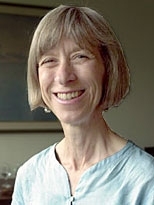How are human beings reacting to displacement of their natural, or "given," world by a built world? This question lay at the heart of a talk given by Professor Rosalind Williams on Nov. 27, the last in a series of fall colloquia titled, "The Big Questions," presented by the Program in Science, Technology and Society (STS).
Williams, the Bern Dibner Professor of the History of Science and Technology and president of the Society for the History of Technology, observed that humans are struggling even to find a language with which to discuss the sweeping changes that are occurring in the physical world.
"To call it 'the conquest of nature' is triumphalist and inaccurate," she noted, because the phrase puts humankind outside the realm of nature and sets both humankind and nature outside of history. Other formulations, such as the distinction drawn between "first nature" and "second nature," are more helpful, but she finds this language too coarse-grained to tease out the complex stages and manifestations of the human-built environment.
In her research as a historian, Williams has studied the effects of the transformation of the "given" planet into a human-built world. She studied the imagined worlds of 19th-century fiction, especially the many underground (and hence completely human-built) worlds, in her 1990 book, "Notes on the Underground: An Essay on Technology, Society and the Imagination."
This focus on how technology affects humans persists in her latest book, she said. "In 'Retooling: A Historian Confronts Technological Change,' I dealt with the question of whether the digital world is a new environment for human life, and if so, what are the implications for engineering education and practice, especially at MIT," she said.
In 1999, even as the built world was being dismissed as passé relative to the virtual world, MIT was embarking on an ambitious building program. "The iconic image of MIT continues to be the Infinite Corridor," Williams observed wryly.
The galloping growth of the human-built world, she believes, generates feelings of loss and mourning that the word "nostalgia" is inadequate to describe.
To try to get a handle on this emotional process, Williams has turned to the study of literature. Nineteenth-century European writers on both sides of the English Channel were articulate witnesses to three great waves of change: the overthrow of "Neolithic" agriculture; the Second Industrial Revolution; and the end of the Age of Exploration, which was openly discussed as "the end of the world." Out of this revolution in our understanding of the planet, its possibilities and limitations, came a literary figure of key interest to Williams, the prolific French novelist Jules Verne.
Verne is best known for three of his more than 60 works of fiction--"Journey to the Center of the Earth" (1864), "Around the World in Eighty Days" (1873) and "Twenty Thousand Leagues Under the Sea" (1870). One critic has called Verne's works "romances or comedies of globalization."
In her STS talk, Williams focused on "Twenty Thousand Leagues," in which she found a saga of grappling with the end of conventional journeys of exploration and the beginning of a new relationship among humans, science and space. She described Captain Nemo, the misanthropic commander of the fictional undersea vessel Nautilus, as the prototype of a new "info-hero," one who uses science and technology to escape the crowded terrestrial regions and to chart a course into the few unexplored parts of the world. (Verne's Nemo inspired the 2003 animated film, "Finding Nemo.") As Williams put it, "Verne is a revealer of the origins of world alienation," the disaffection of humankind with the built world of its own making.
A version of this article appeared in MIT Tech Talk on December 6, 2006 (download PDF).






